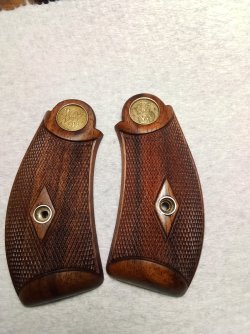Greetings,
My last post was "My latest acquisition" And the revolver came with the incorrect stocks. I just got a correct set of stocks (Silver Medallion) but they looked in a lot better condition on Ebay than what arrived in the mail. Wouldn't make that much of a difference if the revolver they were going on wasn't in such nice condition. Sox drawer revolver with working gun set of stocks.
The question is how difficult is it to "refresh" a set of stocks? No chips or deep scratches but the parts of the checkering are flattened. Your opinion or is it better to keep an eye out for a better set and sell these.
For those that are interested the stamped serial number on the stocks is 726546
Thanks in advance
My last post was "My latest acquisition" And the revolver came with the incorrect stocks. I just got a correct set of stocks (Silver Medallion) but they looked in a lot better condition on Ebay than what arrived in the mail. Wouldn't make that much of a difference if the revolver they were going on wasn't in such nice condition. Sox drawer revolver with working gun set of stocks.
The question is how difficult is it to "refresh" a set of stocks? No chips or deep scratches but the parts of the checkering are flattened. Your opinion or is it better to keep an eye out for a better set and sell these.
For those that are interested the stamped serial number on the stocks is 726546
Thanks in advance

